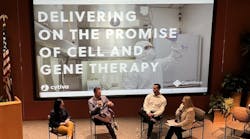Aseptic processing expert and consultant Jim Agalloco is not one to beat around the bush. His vision of the future pharmaceutical facility is one that has immense potential—in terms of advanced automation and robotics, and eliminating human intervention into the processing environment—but his enthusiasm is dampened by the realization that manufacturers won’t embrace technological change in the future any more than they have in the past.
PhM: Your vision of the future is one of automated processing environments free from human intervention. How can we get there?
J.A.: It’s a matter of taking the technology that’s already there and using it. I don’t think that we need to invent new stuff, that there’s anything out there that we don’t yet have. To some people it sounds crazy, because we don’t see this kind of high-end automation a lot. Someone just needs to have the foresight—or maybe that’s not the right word—the audacity to say, “It’s time.”
PhM: But there are plenty of people out there who have legitimate reasons for not pursuing the kinds of technology that you’re talking about.
J.A.: You know what, we make our own challenges. We make our own barriers to innovation all the time in this industry. There are other industries that are using technologies a heck of a lot more than we are. Electronics is a perfect example. Do people use robotics to make their processes more efficient? Absolutely, all the time. And yet we are paralyzed. You don’t see robotics and a lot of high-end technologies in use on our part.
It’s a huge mistake. The opportunities and technologies are there, we just don’t embrace them. We’re very comfortable using not just last year’s but last century’s technologies.
PhM: For some, there’s not a clear ROI to be audacious and to try something new.
J.A.: That’s an assumption they’re making. What is the cost of labor in our country? It’s pretty high, and could we not use machines to offset that labor cost? Why is it okay for the automobile industry but not for us? What’s our downside? We don’t really know what the downside is, we just think there is one.
PhM: There are regulatory hurdles, of course.
J.A.: I think [FDA and other regulators] are ready to embrace it. They’ve gotten to a point of understanding that they know this is a way to make processes safer by taking the operator out of the equation. If we believe that operators are the source of contamination, why wouldn’t they jump on opportunities to take the operator out of the environment?
PhM: Certainly there are manufacturers out there that are pushing the envelope?
J.A.: There are a few, but not nearly as many as there needs to be. Take a trip to Japan, anywhere in Japan. You see robotics and all kinds of things going on where they’ve brought the labor content way down.
We don’t do that. We do it in fits and starts. We do it slowly. Is there any poster child I can point to? None that I can point to, and that’s sad.
PhM: You see an “unmanned operation” as feasible then?
J.A.: Absolutely. Why not? What would prevent us other than our own prejudice?
PhM: What about contract manufacturers? Do you see them being more aggressive in adopting these technologies?
J.A.: I see them as less aggressive. They’re too squeezed financially. A lot of them attract business simply by being low-cost producers. I see them as technological laggards.
PhM: Are the vendors themselves pushing these technologies enough?
J.A.: How far can you be ahead of your customers? That’s the problem. That’s holding them back. If there’s no market for something, they’re opposed to pushing something faster than the market is ready to accept it.
Are there visionaries there? Yes, there are ideas. There’s people doing stuff that are ahead of the game. [Agalloco mentions a few vendor companies that have advanced isolation technologies, such as Canadian firms ATS Automation Tooling Systems and VanRx, and Belgium’s Aseptic Technologies.] At what point do we take that step? Do we just go along forever at this mediocre level of technology that we think is high-tech? We’re not even close.
PhM: So what are a few pieces of advice that you would have to move people towards using more advanced aseptic technology.
J.A.: First thing I’d say is, “Look in the mirror.” There’s your contamination source. If you acknowledge that first, then you can fix it. People don’t really accept that they’re as big of a problem as they really are. We tolerate lower-tech technology than we should because it’s convenient to have Mike or Susan in the cleanroom, but that’s not where we’ve got to be.
Then I’d tell people, look at your cell phone, look at your automobile. They’re so inexpensive these days. The cost to manufacture cell phones is practically free. How is that possible? With automation. With technology. Why are we afraid of it?
Sure, there are a few products like orphan drugs that don’t lend themselves to major investments in automation, but there are a lot of monsters out there that could really use it.
I’m very frustrated. I see what could be, but we’re moving very, very slowly. . . . I wish I could be optimistic but I’m not.





